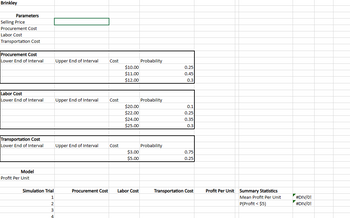following table. Procurement Cost($) 10 11 12 on is Probability 0.25 0.45 0.30 Labor Cost ($) 20 22 24 25 Probability 0.10 0.25 0.35 0.30 (a) Compute profit (in $) per unit for the base-case scenario. $ x /unit (b) Compute profit (in $) per unit for the worst-case scenario. $4 /unit (c) Compute profit (in $) per unit for the best-case scenario. $4 /unit Transportation Cost ($) 3 5 Probability 0.75 0.25 Oduct. The samy P Will De 30 pr cost, the
following table. Procurement Cost($) 10 11 12 on is Probability 0.25 0.45 0.30 Labor Cost ($) 20 22 24 25 Probability 0.10 0.25 0.35 0.30 (a) Compute profit (in $) per unit for the base-case scenario. $ x /unit (b) Compute profit (in $) per unit for the worst-case scenario. $4 /unit (c) Compute profit (in $) per unit for the best-case scenario. $4 /unit Transportation Cost ($) 3 5 Probability 0.75 0.25 Oduct. The samy P Will De 30 pr cost, the
A First Course in Probability (10th Edition)
10th Edition
ISBN:9780134753119
Author:Sheldon Ross
Publisher:Sheldon Ross
Chapter1: Combinatorial Analysis
Section: Chapter Questions
Problem 1.1P: a. How many different 7-place license plates are possible if the first 2 places are for letters and...
Related questions
Question

Transcribed Image Text:Brinkley
Parameters
Selling Price
Procurement Cost
Labor Cost
Transportation Cost
Procurement Cost
Lower End of Interval
Labor Cost
Lower End of Interval
Transportation Cost
Lower End of Interval
Model
Profit Per Unit
Simulation Trial
1
2
3
Upper End of Interval
Upper End of Interval
Upper End of Interval
Procurement Cost
Cost
Cost
Cost
$10.00
$11.00
$12.00
$20.00
$22.00
$24.00
$25.00
$3.00
$5.00
Labor Cost
Probability
Probability
Probability
0.25
0.45
0.3
0.1
0.25
0.35
0.3
0.75
0.25
Transportation Cost
Profit Per Unit Summary Statistics
Mean Profit Per Unit
P(Profit < $5)
▼
#DIV/0!
#DIV/0!

Transcribed Image Text:The management of Brinkley Corporation is interested in using simulation to estimate the profit (in $) per unit for a new product. The selling price for the product will be $46 per unit. Probability distributions for the purchase cost, the labor cost, and the transportation cost are estimated in the
following table.
Procurement
Cost($)
10
11
12
Probability
0.25
4
0.45
0.30
Labor
Cost ($)
20
22
24
25
Probability
0.10
0.25
0.35
0.30
(a) Compute profit (in $) per unit for the base-case scenario.
$
x /unit
(b) Compute profit (in $) per unit for the worst-case scenario.
$4
/unit
(c) Compute profit (in $) per unit for the best-case scenario.
/unit
Transportation Probability
Cost ($)
3
5
0.75
0.25
(d) Construct a simulation model to estimate the mean profit (in $) per unit. (Use at least 1,000 trials. Round your answer to two decimal places.)
(e) Why is the simulation approach to risk analysis preferable to generating a variety of what-if scenarios?
Simulation will provide ---Select--- ✓✓ of the profit per unit values which can then be used to find ---Select---
✓ of an unacceptably low profit.
(f) Management believes the project may not be sustainable if the profit per unit is less than $5. Use simulation to estimate the probability the profit per unit will be less than $5. (Round your answer to three decimal places.)
Expert Solution
This question has been solved!
Explore an expertly crafted, step-by-step solution for a thorough understanding of key concepts.
This is a popular solution!
Trending now
This is a popular solution!
Step by step
Solved in 2 steps

Follow-up Questions
Read through expert solutions to related follow-up questions below.
Follow-up Question

Transcribed Image Text:The management of Brinkley Corporation is interested in using simulation to estimate the profit (in $) per unit for a new product. The selling price for the product will be $46 per unit. Probability distributions for the
purchase cost, the labor cost, and the transportation cost are estimated in the following table.
Procurement
Cost($)
10
11
12
7
Probability
0.25
0.45
X
0.30
Labor
Cost ($)
20
X
22
24
25
Probability
0.10
0.25
(a) Compute profit (in $) per unit for the base-case scenario.
$18
/unit
0.35
(b) Compute profit (in $) per unit for the worst-case scenario.
$ 2 4
/unit
0.30
(c) Compute profit (in $) per unit for the best-case scenario.
$313
✓ /unit
Transportation
Cost ($)
3
5
Probability
(d) Construct a simulation model to estimate the mean profit (in $) per unit. (Use at least 1,000 trials. Round your answer to two decimal places.)
$
0.75
0.25
(e) Why is the simulation approach to risk analysis preferable to generating a variety of what-if scenarios?
Simulation will provide 5 a distribution
of the profit per unit values which can then be used to find the probability
(f) Management believes the project may not be sustainable if the profit per unit is less than $5. Use simulation to estimate the probability the profit per unit will be less than $5. (Round your answer to three decimal
places.)
of an unacceptably low profit.

Transcribed Image Text:Brinkley
Parameters
Selling Price
Procurement Cost
Labor Cost
Transportation Cost
Procurement Cost
Lower End of Interval
Labor Cost
Lower End of Interval
Transportation Cost
Lower End of Interval
Model
Profit Per Unit
Simulation Trial
1
2
3
4
Upper End of Interval
Upper End of Interval
Upper End of Interval
Procurement Cost
Cost
Cost
Cost
$10.00
$11.00
$12.00
$20.00
$22.00
$24.00
$25.00
$3.00
$5.00
Labor Cost
Probability
Probability
Probability
0.25
0.45
0.3
0.1
0.25
0.35
0.3
0.75
0.25
Transportation Cost
Profit Per Unit Summary Statistics
Mean Profit Per Unit
P(Profit < $5)
#DIV/0!
#DIV/0!
Solution
Recommended textbooks for you

A First Course in Probability (10th Edition)
Probability
ISBN:
9780134753119
Author:
Sheldon Ross
Publisher:
PEARSON


A First Course in Probability (10th Edition)
Probability
ISBN:
9780134753119
Author:
Sheldon Ross
Publisher:
PEARSON
